Wednesday, April 7
Paula: Today we were on our own in Kyoto and hoped to do a bit of shopping before we take a train to the countryside tomorrow. Unfortunately, we had difficulty finding the bargains we have come accustomed to in China and Southeast Asia and this made our shopping experience somewhat frustrating. The antique stores were extremely expensive and we soon realized that our desire to find an old tanuki (raccoon dog deity) was just not realistic. This cute Shinto god is commonly seen outside Japanese homes, stores and in gardens. The tanuki acts as a protector, and like the Indian god Ganesh, represents seven characteristics of a good life.
Next on our list was a tea set. Again these were outrageously expensive in the antique stores - thousands of dollars for the standard pot and five small cups. Even when we looked in tea shops and finally a department store, we found the traditional tea sets to be quite expensive. We were reluctant to make such a purchase for fear we could not safely ship it back to the states. Alas, we have decided to place our hopes on the internet and wrote down the names of some of the manufacturers. Later this week, we will try to purchase a set on-line, like the ones we enjoyed seeing during our stay in Kyoto.
While tea sets are expensive, certainly we could afford attending a traditional tea ceremony, and so our next stop was at such an establishment near the Path of Philosophy. The tea ceremony is an art with a long history in Japan. So after paying over $10 per person, we expected to learn something about the history of the tea ceremony, get a sense for the rituals involved, and taste some particularly fine tea.
We quickly realized that this was something different from what we expected, as we filed into the tea house with ten other Japanese guests and took our seats in front of a small table. Two young women in kimonos passed out sweets (rice gelatin balls filled with beans) while a third woman prepared a small bowl of tea in the front of the room. The tea and water was carefully measured and mixed with a bamboo whisk. Within a few minutes the bowl of tea was presented to David. David actually was occupying the head seat in the room, and this was a bit of a problem not only because he had no idea of what to do, but also because the women in kimonos showed no interest in trying to communicate with us and no one was explaining what we where supposed to do. Fortunately a kind Japanese woman next to us motioned instructions and David played along.
We had expected an extensive and interesting ritual, with perhaps some accompanying
explanation, but there was really very little to what we saw. The tea bowl
is turned 180 degrees and then sipped until it is gone while carefully holding
one hand under the bowl and one on the side. The only other trick is to bow
each time you are served. As we finished the first cup of green tea (and it
was the greenest tea we have ever seen), Steve jokingly said, "Well,
I guess that's it," fully expecting much more. To our surprise everyone
began picking up their things and filing out - in fact, we were done and had
just spent over $45 in five minutes on four small cups of tea and four sweets
that we didn't care for. What a disappointment! We have read and heard much
about the traditional tea ceremony and its importance to historical Japanese
culture, but think we really got taken for a ride here today. The amazing
thing was that the Japanese guests seemed to know exactly what to expect,
yet had no problem paying the $10 for the 5 minute "event"!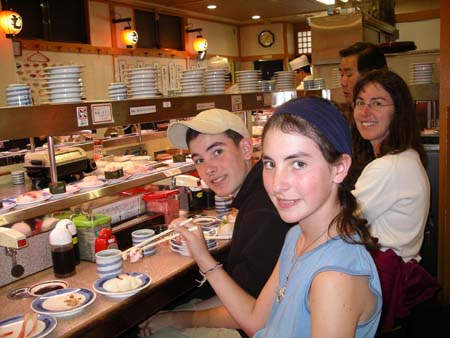
The best part of our day was actually lunch. We popped into a sushi bar where plates of sushi revolve on a conveyer belt. Patrons sit on the outside of this belt and for 100 yen ($1.00) a plate can take whatever they want right off the belt. We enjoyed raw octopus, squid, tuna, shrimp, clams and a few other "unknowns." There were also small boiling water dispensers along the bar wall to make green tea. We have seen many of these sushi bars throughout our stay and this one was very busy. We decided this must be Japanese fast food!
After relaxing during the last part of the afternoon, we left for a "Shabu-Shabu"
dinner at a restaurant called Gyu Zen. Shabu-Shabu actually means "swish,
swish", which is a very appropriate name for this type of food. We were
seated in our own private room with a pot of boiling water, several trays
of thinly sliced meat, noodles and various vegetables. The water is used to
prepare the meat, which after only a few quick "swishes" is cooked
and ready for dipping in either a soy or sesame sauce. The vegetables and
noodles are also cooked in this way. We ordered an "all you can 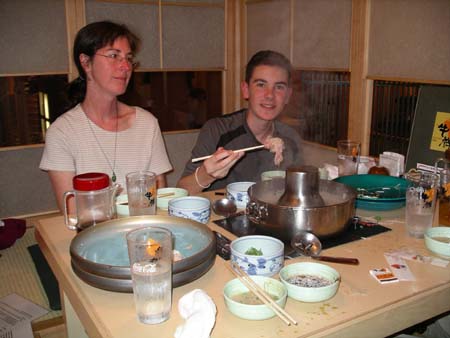 eat"
meal, where we were allowed to enjoy as much food as we wanted within a two
hour period. Our private room came complete with an electronic buzzer that
we pressed each time we were ready to order more food. It was all wonderful,
and very different!
eat"
meal, where we were allowed to enjoy as much food as we wanted within a two
hour period. Our private room came complete with an electronic buzzer that
we pressed each time we were ready to order more food. It was all wonderful,
and very different!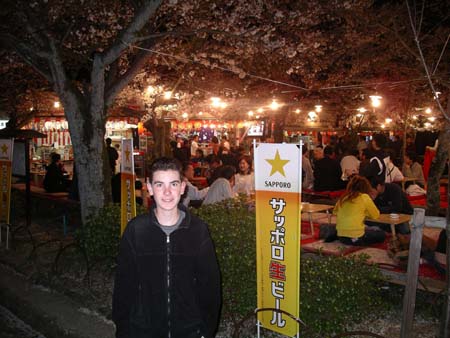
After dinner, we took a quick walk through Maruyama Park, which is the scene of a great deal of evening activity. Large groups of Japanese spread tarps and partake in outdoor parties. Several vendors sell a variety of foods, and there are even carnival-type games for entertainment. We would have stayed longer, but unfortunately it started raining so we grabbed a cab back to the hotel.
Tomorrow we are taking a train from Kyoto to a small village on the island of Shikoku, where we'll spend the next two days. We have arranged homestays on Shikoku, which should be a very interesting experience…
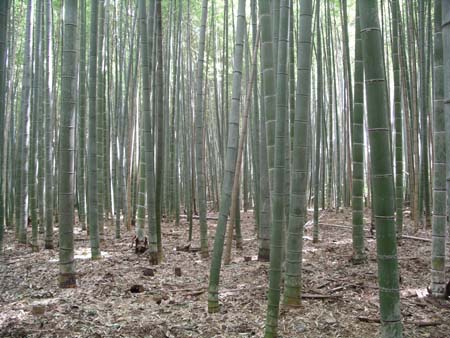
David's Daily Dump: Bamboo. All throughout Asia, from the Laos countryside
to the streets of Kyoto, we have seen one of the most widely used trees in
the world by humans: BAMBOO. I have taken a particular interest in bamboo
and all the unique ways we have seen it being used. Every time I see a patch
or impenetrable forest of bamboo, I walk up to it and marvel at its height
and strength, fantasizing how I would use it to build a bamboo fort.
Bamboo is technically a member of the grass family and grows abundantly through Southeast Asia. There are over 400 different species of this plant which grow at rapid pace. It is said that you can watch bamboo growing since it grows up to three feet a day!!! Incredible!! Some species can grow up to over 160 feet tall and 12 inches in diameter! Just yesterday we got to walk through a huge bamboo forest with hundreds and hundreds of tall magnificent trees. I loved feeling how strong they were and admiring their incredible height. The bamboo trees are easily recognizable by their long tall structures and the nodes which appear to be lines from the outside. These nodes are really shelves inside the bamboo that create pockets of air which can be used for cups or pencil holders. In fact, all parts of the tree are used…some even for food!
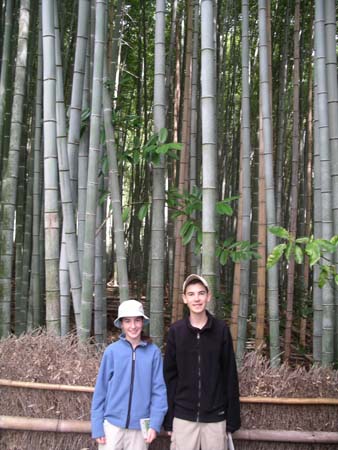 It's
really amazing how many different uses bamboo has. We have seen many cool
things made of bamboo including mats, hats, chopsticks, toys, paper, and fishing
poles. Various tools, pots, cups, baskets, water pipes, and musical instruments
are also made with bamboo. The young bamboo shoots are eaten and can be very
expensive (especially in Japan where everything is expensive).
It's
really amazing how many different uses bamboo has. We have seen many cool
things made of bamboo including mats, hats, chopsticks, toys, paper, and fishing
poles. Various tools, pots, cups, baskets, water pipes, and musical instruments
are also made with bamboo. The young bamboo shoots are eaten and can be very
expensive (especially in Japan where everything is expensive).
One of the main uses of bamboo is construction. Houses, bridges, boats, and rafts can be constructed with bamboo. In fact some organizations and bamboo experts are working to encourage more construction with bamboo in third world and undeveloped countries. Houses can easily be made with bamboo which is proven to be twice as strong as concrete, as tough as steel, and ten times easier to build with than timber! Bamboo can be harvested annually while lumber takes over 20 years to grow! Bamboo homes can survive earthquakes, and last over thirty years. It is much easier to grow bamboo than to make concrete or steel. It is said that a short piece of bamboo with a surface area of 10 square centimeters could hold an 11,000 pound elephant!!!
I have really enjoyed learning and researching about bamboo. I have especially liked walking into rural Southeast Asian villages and seeing all the different uses of this magnificent plant. Maybe someday I will be able to build my bamboo fortress or build a bamboo bridge!
